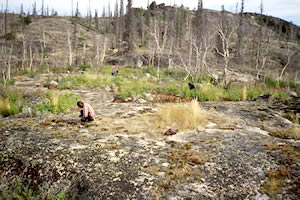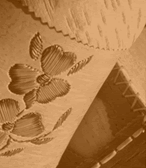|
Exploring the Place |
|
|
A Dogrib account of caribou fences
"Long ago, caribou were scarce. When it was getting warm, and time for them
to migrate back to the barrenlands, my father told me that at this place they
would make a fence [on the ice]. It's hard to cut down that many trees, but
still they did that. When they started to come, the men would wait alongside
the trails all night. When the caribou come onto the lake, and as soon as they
passed them near the fence, the men would imitate wolves. The caribou become
scared, as they think they are being chased by wolves...
The fence has openings in it, and it is there that the snares are set. When
a caribou is caught, the one behind it would try another opening and it would
get caught too.
In between the trees on the ice they would put a piece of cloth on a stick
and stand it up so that it blows in the wind. The caribou does not go through
the fence because it is scared of the moving cloth. The only openings are where
the snares are, my father said."
Romie Wetrade, March 3, 1992
|
|
|
| |
|
| |
|
| |
| | In the quote to the left, Romie Wetrade describes the construction and operation
of a fence which was located near the present community of Rae Lakes (Gameti).
Harry Simpson, as a young child in the mid-1930s, helped construct a fence at
Kwiika , or 'fence narrows'. He identified five related sites which constitute
the fence complex: the fence itself, a location where hunters hid waiting to ambush
the caribou near the end of the fence, a 'look-out' located on a high hill nearby,
a butchering location, and an encampment some distance from the fence.
| |
| |
|
|
|
 |
| Inspecting the site at Fence Narrows (Tom Andrews/ | |
|

